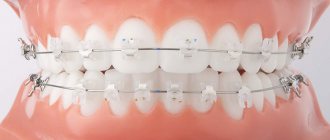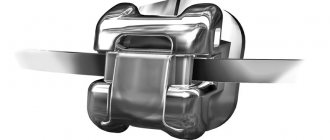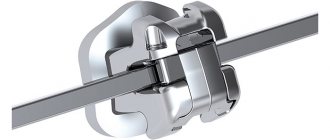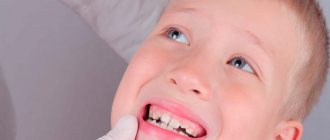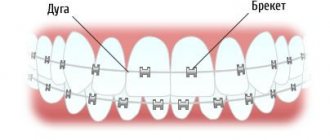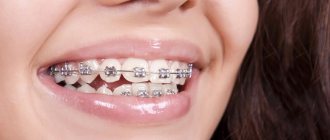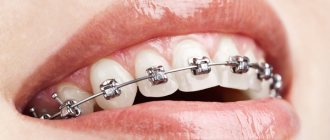Classic braces systems are fairly voluminous structures that provide gradual displacement of teeth in the required direction due to an arch firmly attached to the braces using elastic ligatures - rubber bands. But most patients are embarrassed by the lack of aesthetics of such systems, the discomfort that occurs when such a brace system is overloaded, as well as other difficulties that arise during dental care. Specialists in the field of aesthetic dentistry, creating new types of tools for straightening the bite, tried to take these points into account as much as possible, and thus self-adjusting braces came into the arsenal of orthodontists, differing from conventional ones in the absence of any additional mechanisms.
Such braces do not require conventional ligatures. The already outdated rubber bands have been replaced by reliable latches. At the same time, an overdose of forces is almost completely eliminated, since when overloaded, the clip seems to release the arc, allowing it to move without problems like sliding doors. This also allows you to correct your bite and significantly reduce treatment time. In addition, there is no need for regular visits to the orthodontist’s office, since there is no need to change an elastic ligature that is broken/damaged during use. Self-adjusting braces are examined by an orthodontist once every couple of months - this is enough for safe and correct treatment.
What are self-ligating braces?
The operating principle of a non-ligature construction is easiest to understand if you compare it with a ligature construction.
Classic ligature braces: clasps are fixed on the surface of each tooth and connected to each other by an orthodontic arch. The clasps and arch are attached to each other with fasteners - ligatures. They can be special rubber bands or wires. These elements gradually move the teeth and bite into the position specified by the orthodontist. This happens due to the teeth overcoming the frictional force. The disadvantage of ligatures is that during the treatment they need to be changed frequently, as they stretch, cease to perform their function, plus they lose their original aesthetic appearance - they change color.
To make orthodontic treatment more comfortable for the patient, manufacturers of dental corrective structures have developed braces without ligatures. They differ from classic ligature ones in the way the clasps and arches are connected: the latches in them are replaced with special latched covers built directly into the clasps themselves. It turns out that the locks seem to be strung on an arc, and not attached to it with “clothespins”.
During treatment with ligature-free braces, the frequency of visits to the dentist is reduced: the fixing elements in them do not fail, so the structure needs to be adjusted much less frequently.
Price
The cost of orthodontic treatment depends on the manufacturer and material. Our clinic has promotional offers that provide payment in installments for treatment.
What is included in the cost of the annual course and payment terms:
- diagnostics - free;
- braces + installation - first payment (the amount depends on the type of system);
- corrections, consultations - monthly, fixed payment for all types of braces;
- withdrawal is free.
Wearing ligature and non-ligature braces: what is the difference?
Both types of structures effectively perform their task - correct the pathology of teeth closure, return teeth to the anatomically correct position. But for the patient, the process of wearing them will be different.
- Non-ligature designs look neater, “lighter”, more inconspicuous: they have no additional elements, and the clasps themselves are smaller.
- Caring for self-ligating systems is much easier: metal and rubber ligatures often contain food fragments and need to be cleaned more thoroughly and for longer.
- The main difference we have already mentioned is the frequency of correction. When wearing classic ligature braces, you need to visit the orthodontist every three to four weeks, and when wearing non-ligature braces - every six to eight weeks. For many patients, this is a decisive moment when choosing an orthodontic system.
Photos of treatment stages on self-ligating braces
Metal self-adjusting braces
Non-ligature metal braces are the most popular and common type of non-ligature braces. Such metal braces have long proven their effectiveness and cope well even with complex cases. They are used in the correction process even in the most difficult cases.
Such metal bracket systems are characterized by the least aesthetics, but maximum efficiency. At the moment, even patients with allergies can afford metal braces - for them, companies make special systems cast from hypoallergenic materials.
What materials are ligature-free braces made from?
Locks for self-ligating structures are made from the same materials as for classic ligature braces - metal, ceramics and artificial sapphires.
Metal self-ligating braces
They are the easiest to install and remove. These durable, reliable systems correct all malocclusion pathologies and effectively move teeth into the desired position. Cheaper than designs made from other materials, therefore popular with patients.
Self-ligating ceramic braces
They are made from durable white dental ceramics in different shades, so they look more attractive than metal ones. The clasps of such systems are invisible, since the ceramics merge with the tooth enamel. The only noticeable detail is the orthodontic arch. They have one drawback - fragility compared to structures made from other materials.
Sapphire self-ligating braces
Like ceramic ones, they are almost invisible on the teeth. They are, of course, not made from natural sapphires - otherwise their price would be very high. During production, a transparent artificial material is used, the characteristics of which are identical to sapphires. They reflect light and make your smile really sparkle. Sapphire braces are more often used in the treatment of complex malocclusion pathologies; they are stronger than ceramic ones.
Indications for installation
Braces therapy is performed strictly for medical reasons. These are:
- crowding of elements of the dentition or, on the contrary, gaps between them;
- incorrect vector of tooth growth (rotation and (or) tilt);
- moving one of the jaws (or both) forward, backward or to the side;
- uneven development of the jaws;
- incomplete closure of the dentition.
Important: treatment of occlusion disorders is prescribed by a doctor after a visual examination and diagnostics using a hardware method. Depending on the characteristics of a particular clinical case, the specialist recommends one or another type of brace system for correction.
Aesthetic system without ligatures - what is it?
It is widely believed that non-ligature braces are a type of aesthetic system. In fact, this is only partly true.
Aesthetic self-ligating braces include ceramic and sapphire designs. Metal ones, although they look more attractive than ligature systems due to small locks, can hardly be called aesthetic. They look neat, but are much more noticeable than designs made of ceramics and artificial sapphires.
Also, aesthetic non-ligature braces include lingual systems - they are attached to the “lingual”, inner surface of the teeth. Such designs are invisible and are often chosen by public people.
The only drawback of non-ligature aesthetic systems is their high price. In order to reduce it, dentists combine materials: in the frontal zone, sapphire or ceramic clasps are fixed on the upper teeth, and metal ones on the lower jaw, chewing teeth.
Main brands of self-ligating non-ligating braces
Popular brands of non-ligation systems include Damon, Clarity, Experience, In Ovation, H4.
Damon.
Perhaps the most famous brand of braces without ligatures. Its product line includes designs to solve any problems with bite and misalignment of teeth. The main advantage of these American systems is the damper mount developed by the company. It simplifies the archwire replacement process and reduces correction time.
Experience.
Japanese non-ligature designs, characterized by the small size of the clasps and their structure. Each clasp fits very tightly to the tooth enamel. Plus Experience controls the movement of each tooth.
Clarity SL.
Damon's main competitors. They are made of ceramic, but the groove in their clasps is made of stainless steel. This guarantees smooth sliding of the arc, as in metal systems. At the same time, they are classified as aesthetic systems, since they are invisible on the teeth. Treatment duration with Clarity SL is typically reduced by 25%. However, it all depends on the clinical picture.
In Ovation C.
These are ceramic non-ligature structures from the American company DENTSPLY. These systems are designed to prevent incorrect fixation. In Ovation C clasps are 100% protected from discoloration during wear - for this, the manufacturer coated them with a layer of zirconium dioxide.
H4.
Another self-ligating braces made in America. They are distinguished by a low profile of the locks and a minimum size of the groove for the orthodontic arch. Allows better control of treatment at the final stage.
Alternative to self-ligating design
An alternative to a self-ligating design is ligature braces. The word “ligature” comes from the Latin word “ligature” - a ligament. The arch is tightly fixed to each bracket using ligatures and, due to “shape memory,” pulls the teeth in the desired direction. “Classic” models correct various malocclusion pathologies: from anomalies in the position of individual teeth to complex complex cases.
metal ligature braces Mini Diamond
There are wire and elastic ligatures. Wire structures fix the arc as tightly as possible. They are more reliable, but provide worse sliding. Elastics are made from rubber and caoutchouc in various colors. Elastic materials tend to stretch, can sometimes tear and require regular replacement.
Comparison of self-ligating and ligature braces
Depending on the method of fixing the arch sliding in the grooves of the braces, ligature and non-ligature (self-ligating) systems are distinguished.
self-ligating Damon Q2 and Orthos ligature braces
Let's compare self-ligating and ligature models.
1. Method of fixing the arc. In “classical” systems, the arch is held in place by ligatures, and in non-ligature systems, by a lid or clip.
arc in groove Damon Clear
2. Material of manufacture. Ligature and non-ligature devices are made from various materials. Here are some examples:
- Damon Clear2 self-ligating ceramic braces;
- metal Damon Q, 3MX;
- ligature Inspire Ice made from artificially grown sapphire;
- in the manufacture of Orthos and Mini Diamond, the material used is stainless steel;
- Titanium Orthos are made of titanium.
sapphire ligatures Inspire ICE
The choice depends on the clinical case, preferences and financial capabilities of the patient.
3. Price. The cost depends on a number of factors.
- The presence of a mechanism for closing/opening the lid or clip. Due to the complexity of manufacturing, the price of non-ligature self-ligating braces is higher than that of devices with ligatures.
- Materials of manufacture: for example, ceramic ones are more expensive than steel ones.
- Areas of fixation: vestibular, on the outer surface, or lingually, on the inner surface of the dentition. The cost of lingual ones is higher.
4. Duration of treatment. “Classic” devices are worn on average from 2 to 3.5 years. Without ligature – 20–30% less. Bite correction with Dimon can reduce the number of visits and the overall duration of treatment by several months. The period is different for each person. The doctor indicates the approximate period of time after calculating the diagnostic models and the patient’s TRG.
5. Discomfort during treatment . The Damon self-ligating brace system brings less discomfort to the patient due to the work of low forces and reduced friction. In addition, pain sensations depend on individual characteristics: pain threshold and jaw anomalies to be corrected.
6. Treatment effectiveness. Non-ligature structures are capable of correcting clinical cases of varying levels of complexity, gently and carefully building the correct bite. Appliances with ligatures also correct complex jaw anomalies. However, self-ligating braces reduce the time required for bite correction and provide a long retention period.
7. Care. Oral hygiene with ligature devices is more difficult. Food gets stuck between the bracket, archwire, and elastics, and cleaning the system takes longer. If the patient neglects careful hygiene, multiple caries lesions and periodontal diseases are possible. Because of this, additional therapeutic treatment may be required after the structure is removed.
8. Adaptation. Getting used to any type of device is not easy in some cases. A foreign object appears in the oral cavity, which, of course, interferes. Adaptation to the non-ligation system is easier due to the small size and atraumatic shape of the elements. The absence of additional elements in the form of ligatures also makes it easier to get used to.
How are ligature-free systems installed?
The process of fixing self-ligating non-ligature structures is no different from installing classical ligature systems.
- Before fixing the structure, a full examination of the oral cavity is carried out; sometimes, to achieve the desired result of orthodontic treatment, teeth are removed and dentures are installed. All carious lesions must be removed and professional cleaning carried out.
- Locks of the chosen design are fixed to the teeth. This happens with the help of dental glue. This is the most critical stage: incorrectly installed locks will negatively affect the duration and quality of treatment.
- If necessary, the remaining glue is removed, and the clasps are finally secured to the teeth using a lamp with ultraviolet light.
- On the side, on the chewing teeth, orthodontic rings and locks are fixed.
- All installed locks are connected to each other by means of an orthodontic arch, which is fixed in their grooves.
Installation of the system takes about one hour. But the preparatory stage may well last for several weeks or even months - it all depends on the initial condition of the patient’s oral cavity.
Hygienic care of braces
The type of fastening of the arc in the plates, ligature or non-ligature, is not important when it comes to maintaining and cleaning the equipment. Thorough hygienic cleaning of the structure and teeth is necessary every day, morning and evening, as well as after each meal. Due to the shape of the braces system, it is very difficult to remove food debris. According to the recommendations of experts, it is necessary to purchase for personal use: rinse aid solution, special. brush, brush and dental floss. First of all, cleaning is carried out by a large specialist. brushing – removes large amounts of food from all dental surfaces. Then the most inaccessible places are cleaned with a brush. And only at the end - use super-floss. Only by observing all manipulations is it possible to maintain oral hygiene at the proper level. One such procedure will take up to 20 minutes. after every meal. On average, it will take up to 40 minutes per day.
Author:
Which braces to choose - with or without ligatures?
Non-ligature braces look more aesthetically pleasing than classic ligature braces, reduce the number of visits to the orthodontist, correct the bite faster, move teeth more gently, and can be used for periodontal diseases. Thanks to the design of self-ligating systems, the process of their correction takes fifteen to twenty minutes. In addition, the absence of ligatures protects against pain that can occur if the orthodontist “tightens” the ligature.
The disadvantage of self-ligating structures is their high price. Apparently, for this reason, classic ligature systems are still very popular. They are especially often chosen by teenagers and young people, who, in addition to saving money, receive another bonus - the opportunity to experiment with the color of the ligatures, making their braces unique, emphasizing their individuality.
In general, when choosing an orthodontic system, doctors and patients are guided by two principles - the ability to effectively get rid of malocclusion pathology and the ability to pay for treatment. Both ligature and non-ligature constructions allow you to achieve the desired result.
Self-regulating braces design reviews
From my own experience, I can say that for the majority of patients, adaptation is quick and painless. After getting used to it, there are no problems with cleaning and eating. All patients are satisfied with the results of the treatment, except for those cases when people think that they overpaid for the design and it was not worth the money. Regarding this, I can say one thing: all designs have their place in modern orthodontics, and choosing a budget design is not always the worst option. At the LeaderStom clinic, our specialists will advise you on any issue on this or any other topic, and will also give you back a beautiful smile.
